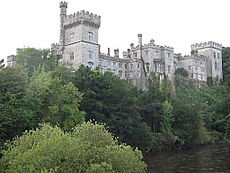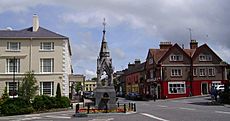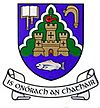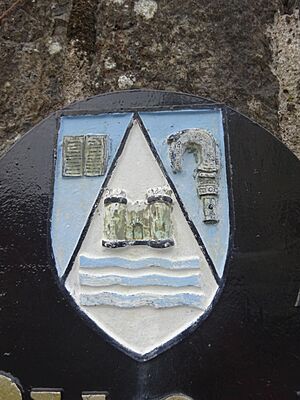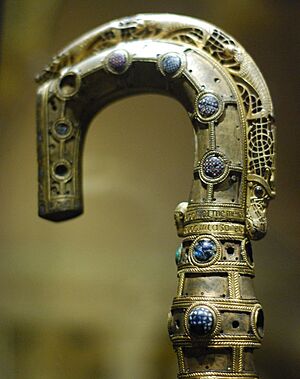Lismore, County Waterford facts for kids
Quick facts for kids
Lismore
Lios Mór
|
||
|---|---|---|
|
Town
|
||
|
Lismore Castle and Main Street
|
||
|
||
| Country | Ireland | |
| Province | Munster | |
| County | Waterford | |
| Elevation | 86 m (282 ft) | |
| Population
(2022)
|
1,347 | |
| Time zone | UTC±0 (WET) | |
| • Summer (DST) | UTC+1 (IST) | |
| Eircode routing key |
P51
|
|
| Telephone area code | +353(0)58 | |
| Irish Grid Reference | X045984 | |
Lismore is a historic town in County Waterford, Ireland. Its name, Lios Mór, means "great ringfort" in Irish. The town grew around Lismore Castle, which was built a long time ago.
Lismore is famous for its early religious history. It was founded by Saint Mochuda in the 7th century. He started Lismore Abbey, a very important religious school. Today, Lismore is a small town that helps the nearby countryside. In 2022, about 1,347 people lived there.
Contents
A Look Back in Time
Lismore was founded by Saint Mochuda, also known as Saint Carthage. He was the first leader of Lismore Abbey. The town is well-known for its old churches and the learning that happened at the Abbey.
The Famous Lismore Castle
Lismore Castle is a huge building that stands on a steep hill. It looks over the town and the Blackwater valley. The castle has a history of 800 years, showing the links between England and Ireland.
It was first built after Prince John arrived in the 12th century. For a long time, it was a palace for bishops. Later, Sir Walter Raleigh owned it. After him, it was sold to Richard Boyle, the First Earl of Cork.
In 1627, Robert Boyle, a famous scientist, was born at the castle. He is known as the "Father of Modern Chemistry" because of his work, like Boyle's law. The castle stayed with the Boyle family for many years. In 1753, it passed to the English Dukes of Devonshire. This happened when Lady Charlotte Boyle married the Marquess of Hartington. He later became the 4th Duke of Devonshire.
Important Books and Treasures
The Book of Lismore is a collection of old Irish writings. It tells stories about Irish saints like St Brigid and St Patrick. It also has a very important story called Acallam na Senórach. This story is about the Fenian Cycle, a group of Irish legends.
The Book of Lismore and the Lismore Crozier were found together in 1814. They were hidden behind a blocked-up door in Lismore Castle. The Crozier is a special staff that belonged to the abbey's founder. Today, the castle is still owned by the Dukes of Devonshire. They open the gardens and some parts of the castle for visitors. The Book of Lismore is now owned by University College Cork. The Lismore Crozier is in the National Museum of Ireland in Dublin.
Churches and Buildings
The old Lismore Cathedral is dedicated to St Carthage. It has been damaged and fixed many times over the centuries. It is known for its beautiful architecture and a stained glass window by Edward Burne-Jones. People have worshipped here since the 7th century. The building you see today was built in the 17th century.
Lismore Courthouse was finished in 1815. St Carthage's Church is a Roman Catholic church in the town. It is also dedicated to St Carthage and opened in 1884.
Famous Visitors and Residents
A special plaque in Lismore remembers Fred Astaire. He was a famous dancer who often visited the town. His sister, Adele Astaire, was married to a member of the Devonshire family.
Dervla Murphy, a well-known travel writer and cyclist, was born in Lismore. She wrote about her early life there. Another writer, George O'Brien, also grew up in Lismore. He wrote about his childhood in his book The Village of Longing.
In 2003, Blackwater Community School opened. It brought together three local schools into one.
Where is Lismore?
Lismore is in the western part of County Waterford. The N72 road crosses the River Blackwater here. The town is at the foot of the Knockmealdown Mountains. These mountains separate County Tipperary and County Waterford.
Dungarvan is about 21 kilometers (13 miles) east of Lismore. Fermoy is about 24 kilometers (15 miles) to the west.
People in Lismore
| Historical population | ||
|---|---|---|
| Year | Pop. | ±% |
| 1813 | 1,569 | — |
| 1821 | 2,330 | +48.5% |
| 1831 | 2,894 | +24.2% |
| 1841 | 3,007 | +3.9% |
| 1851 | 2,319 | −22.9% |
| 1861 | 2,085 | −10.1% |
| 1871 | 1,946 | −6.7% |
| 1881 | 1,860 | −4.4% |
| 1891 | 1,632 | −12.3% |
| 1901 | 1,583 | −3.0% |
| 1911 | 1,474 | −6.9% |
| 1926 | 1,363 | −7.5% |
| 1936 | 1,194 | −12.4% |
| 1946 | 1,174 | −1.7% |
| 1951 | 1,089 | −7.2% |
| 1956 | 893 | −18.0% |
| 1961 | 1,069 | +19.7% |
| 1966 | 1,046 | −2.2% |
| 1971 | 1,041 | −0.5% |
| 1981 | 1,119 | +7.5% |
| 1986 | 1,085 | −3.0% |
| 1991 | 1,095 | +0.9% |
| 1996 | 1,095 | +0.0% |
| 2002 | 1,182 | +7.9% |
| 2006 | 1,240 | +4.9% |
| 2011 | 1,369 | +10.4% |
| 2016 | 1,374 | +0.4% |
| 2022 | 1,347 | −2.0% |
In 2022, Lismore had a population of 1,347 people. Most residents were white Irish. About 74% of the town was Catholic.
Getting Around
Bus Travel
Since 2015, bus services in Lismore have improved. There are now four bus services each day from Monday to Saturday. These buses go to Dungarvan and Tallow. In Tallow, you can connect to buses going to Fermoy. On Saturdays, a local bus goes to Cork. On Sundays, Bus Éireann has one bus service from Lismore to Dungarvan and Waterford.
Train Travel
Lismore used to have a train station. It was on the line that went from Waterford to Mallow. This line also connected to the train that went from Cork to Rosslare. The train line and station closed in 1967. The old station building is still there today.
Gallery
-
Memorial plaque honouring Fred Astaire on the wall of Madden's Summerhouse Cafe.
Famous People from Lismore
Many interesting people were born or lived in Lismore:
- Robert Boyle (1627–1691): A famous physicist and chemist.
- Dervla Murphy (1931–2022): A well-known travel writer.
- William Henry Grattan Flood (1859–1928): An author, composer, and historian.
- Edmund Duggan (1862–1938): A playwright and actor.
- Dan Shanahan (born 1977): A famous hurler for Waterford.
- Maurice Shanahan (born 1990): Another Waterford hurler.
- John Ormonde (1905–1981): A politician from the Fianna Fáil party.
- Henry Gervais (1712–1790): A priest.
- Patrick Campbell-Lyons (born 1943): A musician.
Other notable residents:
- Adele Astaire (1896–1981): Lived nearby and was often visited by her brother Fred Astaire.
- George O'Brien (born 1945): A writer.
- William Makepeace Thackeray (1811–1863): A famous writer who stayed in Lismore.
Sister Cities
Lismore is twinned with another town that shares its name:
 Lismore, New South Wales, Australia.
Lismore, New South Wales, Australia.
See also
 In Spanish: Lismore (Waterford) para niños
In Spanish: Lismore (Waterford) para niños


